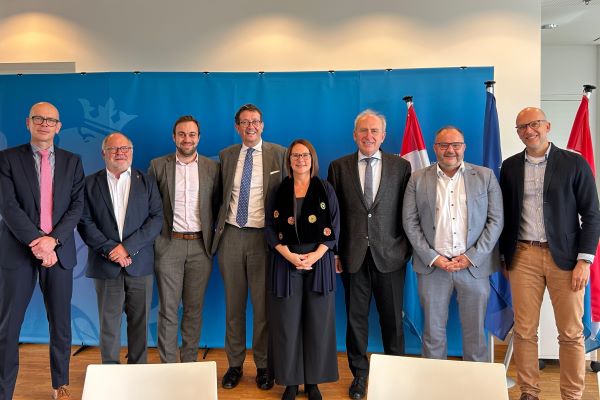 Helge Dorstewitz, Luxtram; Carlo Muller, Reckange-sur-Mess Mayor; Lou Linster, Leudelange Mayor; Maurice Bauer, VdL alderman; Minister Yuriko Backes; Jeannot Fürpass, Mondercange Mayor; Carlo Feiereisen, Schifflange alderman; Frank Vansteenkiste, Luxtram;
Credit: Elza Osmane, Chronicle.lu
Helge Dorstewitz, Luxtram; Carlo Muller, Reckange-sur-Mess Mayor; Lou Linster, Leudelange Mayor; Maurice Bauer, VdL alderman; Minister Yuriko Backes; Jeannot Fürpass, Mondercange Mayor; Carlo Feiereisen, Schifflange alderman; Frank Vansteenkiste, Luxtram;
Credit: Elza Osmane, Chronicle.lu
On Monday 13 October 2025, Luxembourg’s Ministry of Mobility and Public Works presented the latest developments of the “Tram Rapide” (high-speed tram) project connecting Luxembourg City to the south of the country.
The project was introduced during a press conference led by Yuriko Backes, Luxembourg's Minister for Mobility and Public Works, alongside Helge Dorstewitz, Director General of Luxtram SA, and attended by representatives of the seven partner municipalities: Luxembourg City, Esch-sur-Alzette, Leudelange, Mondercange, Reckange-sur-Mess, Sanem and Schifflange.
The project aims to link the two main residential and employment areas of Luxembourg between Cloche d'Or and Belvaux through a single direct line, therefore simplifying travel and eliminating the need for transfers. The route will include main connection hubs in Leudelange, Pontpierre and Foetz.
Studies for the project began in 2023 and construction of both the tram line and the Tramsschapp Cloche d'Or maintenance centre is scheduled to start in 2026, with entry into service expected by 2029 to 2030. According to the ministry, the tram depot will accommodate 24 rapid tram units and seventeen urban tram units, supported by administrative, storage and workshop facilities covering a total area of 25,000 m².
During the briefing, journalists raised questions on various aspects of the project, including financing details and the final route alignment. The discussion addressed the progress of funding legislation and details concerning the Leudelange section, where what appeared to be a detour was explained as an adjustment making use of existing infrastructure such as the Vélo Expressway.
In response, Minister Backes stated that the financing framework is still being prepared, with figures depending on ongoing negotiations and cost evaluations, but assured that “no matter how long it takes, we will be able to do it.” She added that the planned route near Leudelange is not a deviation but an adjustment intended to reduce environmental impact and better connect everyday destinations such as workplaces, schools, restaurants and public facilities.
The presentation also provided practical details mentioning that each tram will stop for around 25 to 30 seconds at stations (similar to the current city network) and the new high-speed tram vehicles will be longer and offer greater passenger capacity.
According to the Ministry of Mobility and Public Works, the project emphasises sustainable design, noise reduction and user comfort, with the station concepts inspired by examples from other European cities such as Łódź, Paris, Montpellier, Reims and Bordeaux.
Speaking with journalists, Minister Backes described the project as “very ambitious, but achievable,” adding that it represents “a major investment in the future of mobility in Luxembourg.”
EO








